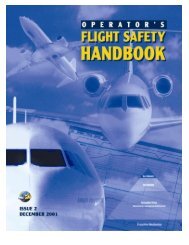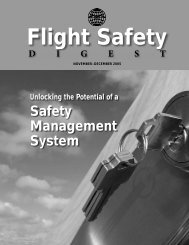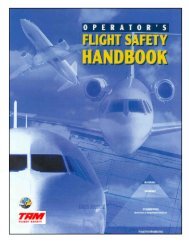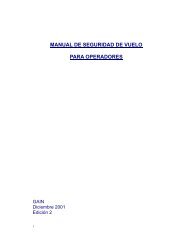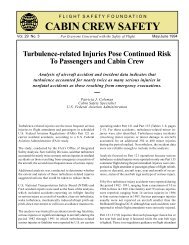Basic Aviation Risk Standard Resource Sector - Flight Safety ...
Basic Aviation Risk Standard Resource Sector - Flight Safety ...
Basic Aviation Risk Standard Resource Sector - Flight Safety ...
Create successful ePaper yourself
Turn your PDF publications into a flip-book with our unique Google optimized e-Paper software.
Appendix 5:<br />
Defences 24.0 (cont.)<br />
Defence 24.12: Cabin Baggage<br />
36<br />
Only soft cover books or securely bound magazines are<br />
permitted as carry-on baggage. Briefcases, laptop computers<br />
and newspapers are specifically prohibited as carry-on<br />
baggage and must be secured in the baggage compartment.<br />
Defence 24.13: <strong>Flight</strong> Following<br />
Dedicated aircraft flight following shall be provided by a<br />
responsible person capable of initiating the Emergency<br />
Response Plan. The flight following at minimum must consist<br />
of constant radio contact being maintained, with aircraft<br />
reporting intervals detailing the aircraft position and altitude<br />
not to exceed 15 minutes.<br />
Where possible, and available for the aircraft type flown, an<br />
approved satellite system shall be provided to augment the<br />
flight following system. Satellite reporting intervals should<br />
be increased to two-minute intervals with higher reporting<br />
frequencies encouraged at lower levels, and can be used in lieu<br />
of the scheduled radio transmissions.<br />
Defence 24.14: Survival Kits<br />
Offshore-specific survival kits, that at a minimum, are to<br />
comply with local regulatory standards are to be carried and<br />
packed into the aircraft liferafts.<br />
Defence 24.15: Emergency Response Plan (ERP)<br />
Provision is to be made for aviation emergencies in offshore<br />
Emergency Response Plans.<br />
Defence 24.16: Emergency Response Drills<br />
Emergency drills (at minimum desk-top) with specific<br />
objectives shall be conducted within 30 days of a new project<br />
start, and annually thereafter for ongoing operations.<br />
To test the integrity of the ERP, worst-case scenarios involving<br />
last-light, weather and aircraft disposition shall be designed<br />
for the exercise.<br />
Bridging communications between the Company, the aircraft<br />
operator and all SAR resources shall be tested and validated<br />
during the drill.<br />
Defence 24.17: Last Light Limitations<br />
Daytime flights offshore are to be scheduled so that<br />
helicopters land 30 minutes prior to official sunset. Daytime<br />
flights offshore, where a ditching prior to darkness would limit<br />
the ability to provide a rescue within the anticipated occupant<br />
survival time, should be further reduced in duration to allow<br />
for appropriate response.<br />
Defence 24.18: Night Time Offshore<br />
Passenger <strong>Flight</strong>s<br />
Night passenger flights shall only be conducted after risk<br />
assessment that involves the aircraft operator. At minimum,<br />
this RA should include:<br />
(1) the existence, availability and effectiveness of available<br />
night SAR resources;<br />
(2) SAR response times; and<br />
(3) survival times of personnel given environmental conditions<br />
and mitigating measures (such as survival suits). In this<br />
review it is expected that dedicated night SAR helicopters<br />
with full night hoisting capability would be available.<br />
Defence 24.19: Linked Liferaft<br />
For long-term operations consideration ought to be given<br />
to request the aircraft operator establish a linked liferaft<br />
capability to supplement any hoist or other means of rescue,<br />
particularly if anticipated sea survival times are marginal.<br />
In addition to initial crew training, an annual currency<br />
requirement is to be maintained.<br />
Defence 24.20: Acoustic Beacon<br />
All offshore helicopters shall have an underwater acoustic<br />
beacon (pinger) that transmits when submerged. If equipped<br />
with a CVR, the pinger should be attached to that CVR.<br />
<strong>Flight</strong> SaFety Foundation BaSic aviation RiSk StandaRd – <strong>Resource</strong> <strong>Sector</strong> © version 3




![Download this Issue [PDF 7 MB] - Flight Safety Foundation](https://img.yumpu.com/18859635/1/190x245/download-this-issue-pdf-7-mb-flight-safety-foundation.jpg?quality=85)
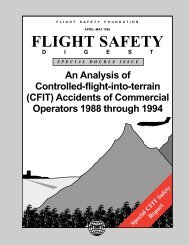
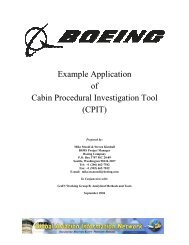
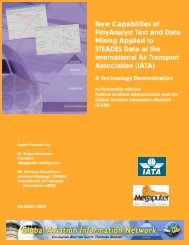
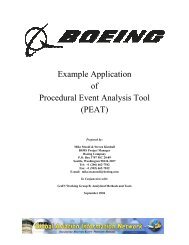
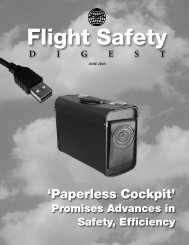
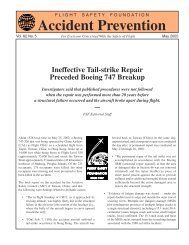
![Download [PDF 8 MB] - Flight Safety Foundation](https://img.yumpu.com/18859366/1/190x245/download-pdf-8-mb-flight-safety-foundation.jpg?quality=85)
